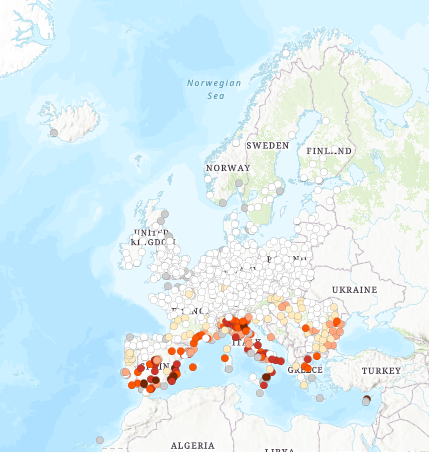0.25 deg
Type of resources
Available actions
Topics
INSPIRE themes
Keywords
Contact for the resource
Provided by
Years
Formats
Representation types
Update frequencies
Scale
Resolution
-

The dataset presents average values of the number of days per year where the maximum temperature has exceeded 35 degrees Celsius from the period 1987- 2016, for a series of individual European cities from Eurostat's Urban Audit 2011-2014 spatial dataset. The associated values are based on the E-OBS dataset from the EU-FP6 project ENSEMBLES (http://ensembles-eu.metoffice.com) and around 10,000 meteorological stations across Europe. This dataset has been used also in the EEA Report No 22/2018 "Unequal exposure and unequal impacts: social vulnerability to air pollution, noise and extreme temperatures in Europe" (https://www.eea.europa.eu/publications/unequal-exposure-and-unequal-impacts/at_download/file).
-

The dataset presents the average number of combined hot days - with maximum temperature over 30 degrees Celsius - and tropical nights - with minimum temperature over 20 degrees Celsius - in the period 1987-2016, for a series of individual European cities from Eurostat's Urban Audit 2011-2014 spatial dataset. The associated values are based on the E-OBS dataset from the EU-FP6 project ENSEMBLES (http://ensembles-eu.metoffice.com) and around 10,000 meteorological stations across Europe. The combination of hot days and warm nights is particularly dangerous to human health, as the high temperatures during night time does not allow for the cities and buildings to cool down. Such combination, if lasting over several days (heatwaves) can have severe health implications or even be fatal to the elderly, babies or those in poor health. Therefore, the knowledge of the occurrence of such conditions in a given location can be useful in planning adaptation to the changing climate and protection of the vulnerable groups from heat. This dataset has been used also in the EEA Report No 22/2018 "Unequal exposure and unequal impacts: social vulnerability to air pollution, noise and extreme temperatures in Europe" (https://www.eea.europa.eu/publications/unequal-exposure-and-unequal-impacts/at_download/file).
-

The dataset presents the annual number of Cooling Degree Days (CDD) in average for the period 1990-2015, for a series of individual European cities from Eurostat's Urban Audit 2011-2014 spatial dataset, based on the E-OBS dataset from the EU-FP6 project ENSEMBLES (http://ensembles-eu.metoffice.com) and around 10,000 meteorological stations across Europe. This dataset has been used in the EEA Report No 22/2018 "Unequal exposure and unequal impacts: social vulnerability to air pollution, noise and extreme temperatures in Europe" (https://www.eea.europa.eu/publications/unequal-exposure-and-unequal-impacts/at_download/file), where CDD is defined as the sum of the difference in degrees between 21 °C and the mean temperature over the year, for the days when the mean daily temperature is higher than 21 °C. The number of CDDs is useful in differentiating between areas based on the need for cooling homes or workplaces. As a measurement designed to quantify the demand for energy needed to cool a building in order to keep it at a comfortable temperature, it is relevant to issues of thermal comfort and energy affordability.
-

The raster dataset (grid 0.25° x 0.25°) presents the trends in frequency of meteorological droughts between 1950 and 2012. Trends are based on a combination of three different drought indices - SPI (Standard Precipitation Index), SPEI (Standardized Preciptation Evapotranspiration Index) and RDI (Reconnaisance Drought Index) accumulated over 12-month periods. The dataset contributes to an earlier version of the EEA indicator "Meteorological and hydrological droughts": https://www.eea.europa.eu/data-and-maps/indicators/river-flow-drought-2/assessment
 RUC Geo-Data catalogue
RUC Geo-Data catalogue